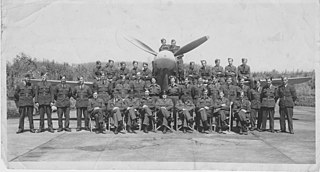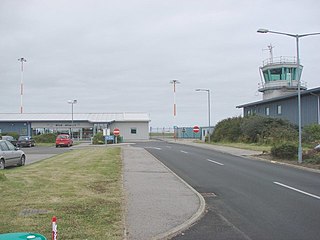
Royal Air Force Waddington otherwise known as RAF Waddington is a Royal Air Force (RAF) station located beside the village of Waddington, 4.2 miles (6.8 km) south of Lincoln, Lincolnshire, in England.

Joint Helicopter Command Flying Station Aldergrove or more simply JHC FS Aldergrove is located 4.4 miles (7.1 km) south of Antrim, Northern Ireland and 18 miles (29 km) northwest of Belfast and adjoins Belfast International Airport. It is sometimes referred to simply as Aldergrove which is the name of a nearby hamlet. The military flying units share the Aldergrove runways but have their own separate facilities and helipad.

Royal Air Force Abingdon or more simply RAF Abingdon is a former Royal Air Force station near Abingdon, Oxfordshire. It is now known as Dalton Barracks and is used by the Royal Logistic Corps.
Royal Air Force Long Kesh or more simply RAF Long Kesh is a former Royal Air Force station at Maze, Lisburn, Northern Ireland.

Royal Air Force Ballyhalbert or more simply RAF Ballyhalbert is a former Royal Air Force station at Ballyhalbert on the Ards Peninsula, County Down, Northern Ireland
Royal Air Force Blackbushe or more simply RAF Blackbushe is a former Royal Air Force station in Hampshire, England, during the Second World War. It is now Blackbushe Airport.
Royal Air Force Prestwick otherwise known as RAF Prestwick, was a RAF unit based at the NATS air traffic control centre, adjacent to Glasgow Prestwick Airport, South Ayrshire, in south west Scotland. The unit was home to the Scottish Air Traffic Control Centre (Military) which provided an air traffic control service to military aircraft operating within its area of responsibility. Prestwick was also home to a Distress and Diversion (D&D) Cell which provided assistance to both military and civil aircraft in an emergency.

Royal Air Force Catterick or RAF Catterick is a former Royal Air Force airfield located near Catterick, North Yorkshire in England. It is located alongside the A6055 road on the outskirts of Catterick Village.
Royal Air Force Bircham Newton or more simply RAF Bircham Newton is a former Royal Air Force station located 2.1 miles (3.4 km) south east of Docking, Norfolk and 13.4 miles (21.6 km) north east of King's Lynn, Norfolk, England.

Wick John O' Groats Airport is located one nautical mile north of the town of Wick, at the north-eastern extremity of the mainland of Scotland. It is owned and maintained by Highlands and Islands Airports Limited. The airport provides commercial air travel connections for Caithness, with scheduled services to Aberdeen Airport and, until early 2020, Edinburgh. It remains regularly used by helicopters servicing local offshore oil operations and the Beatrice Offshore Windfarm. It also serves as a stop-over for light aircraft ferry flights between Europe and North America via Iceland. The airport also operates an out of hours call-out service for air ambulances, coastguard and police flights.

Royal Air Force Colerne or more simply RAF Colerne is a former Royal Air Force station which was on the outskirts of the village of Colerne in Wiltshire, England, and was in use from 1939 to 1976.

Royal Air Force Detling or more simply RAF Detling is a former Royal Air Force station situated 600 feet (180 m) above sea level, located near Detling, a village about 4 miles (6.4 km) miles north-east of Maidstone, Kent.
Royal Air Force Grangemouth or more simply RAF Grangemouth is a former Royal Air Force station located 3 mi (4.8 km) north east of Falkirk, Stirlingshire, Scotland.
Royal Air Force Bramcote or more simply RAF Bramcote is a former Royal Air Force station located 3.5 miles (5.6 km) south-east of Nuneaton, Warwickshire, England used during the Second World War. It later became HMS Gamecock and then Gamecock Barracks.
Royal Air Force Dunholme Lodge or more simply RAF Dunholme Lodge was a Royal Air Force station located between the parishes of Welton and Dunholme in Lincolnshire, England.

Royal Air Force Cranage or more simply RAF Cranage is a former Royal Air Force station operated during the Second World War. It was located just to the North of Middlewich, Cheshire, England.
112 Signals Unit, RAF Stornoway was a classified Royal Air Force (RAF) Electronic countermeasures (ECM) measurement and evaluation unit based at Stornoway Airport on the Isle of Lewis in the Outer Hebrides. It was an RAF Bomber Command Headquarters (HQBC) directly administered unit established during the height of the Cold War.
Royal Air Force Macmerry or more simply RAF Macmerry is a former Royal Air Force satellite station located 4.5 miles (7.2 km) west of Haddington, East Lothian, Scotland and 11.4 miles (18.3 km) east of Edinburgh. It was situated immediately to the north east of Macmerry on the north side of the A1 road. It has also been called RNAS Macmerry and unofficially RAF Tranent and RAF Penston during its life.

Royal Air Force Church Fenton or RAF Church Fenton is a former Royal Air Force (RAF) station located 4.3 miles (6.9 km) south-east of Tadcaster, North Yorkshire, England and 6.3 miles (10.1 km) north-west of Selby, North Yorkshire, near the village of Church Fenton.

Royal Air Force Alconbury or more simply RAF Alconbury is an active Royal Air Force station near Huntingdon, England. The airfield is in the civil parish of The Stukeleys, close to the villages of Great Stukeley, Little Stukeley, and Alconbury. Flying operations are no longer based at the site, with most of the land, including the runway, having been sold in 2009 to become the new settlement of Alconbury Weald.













